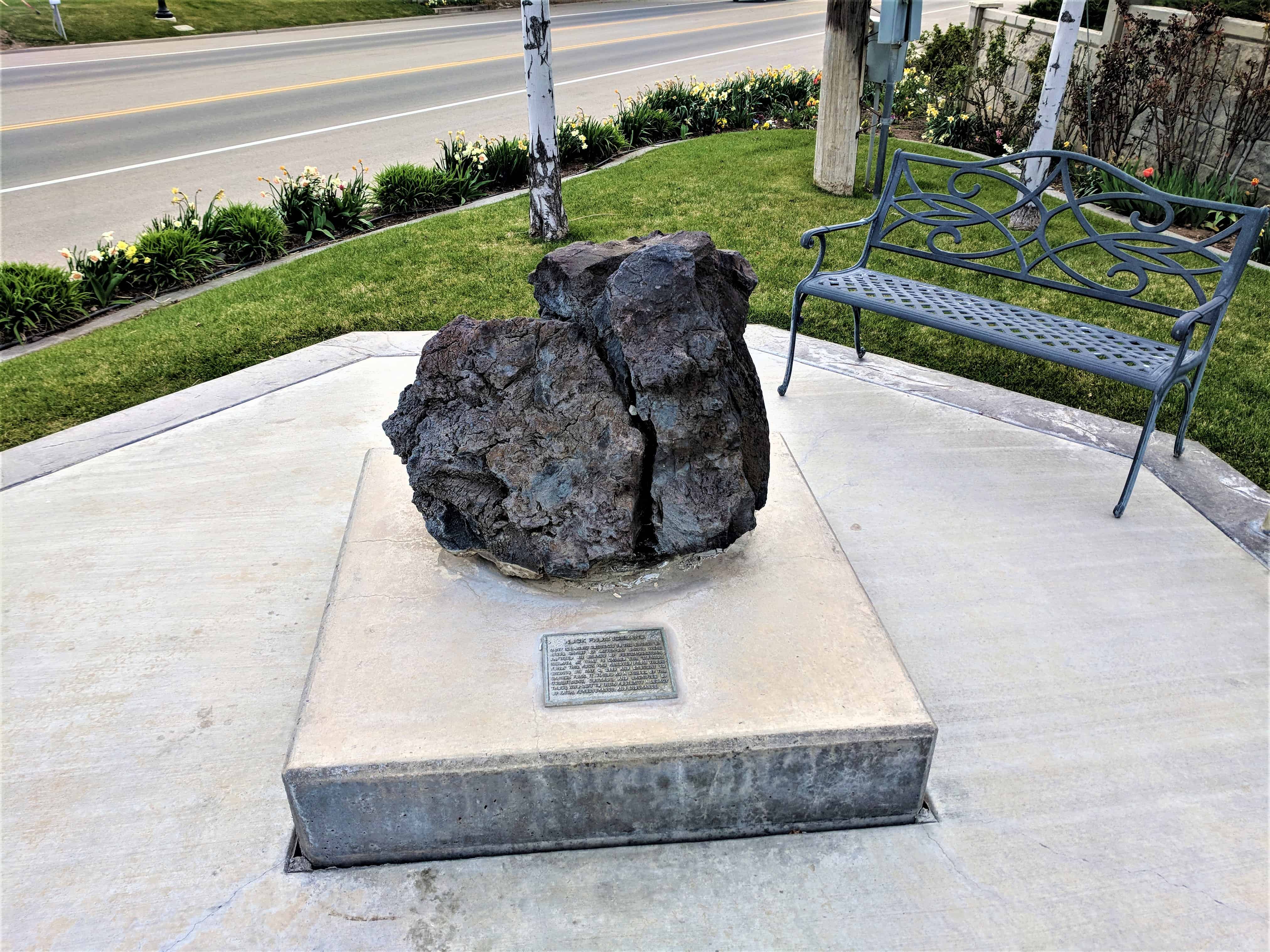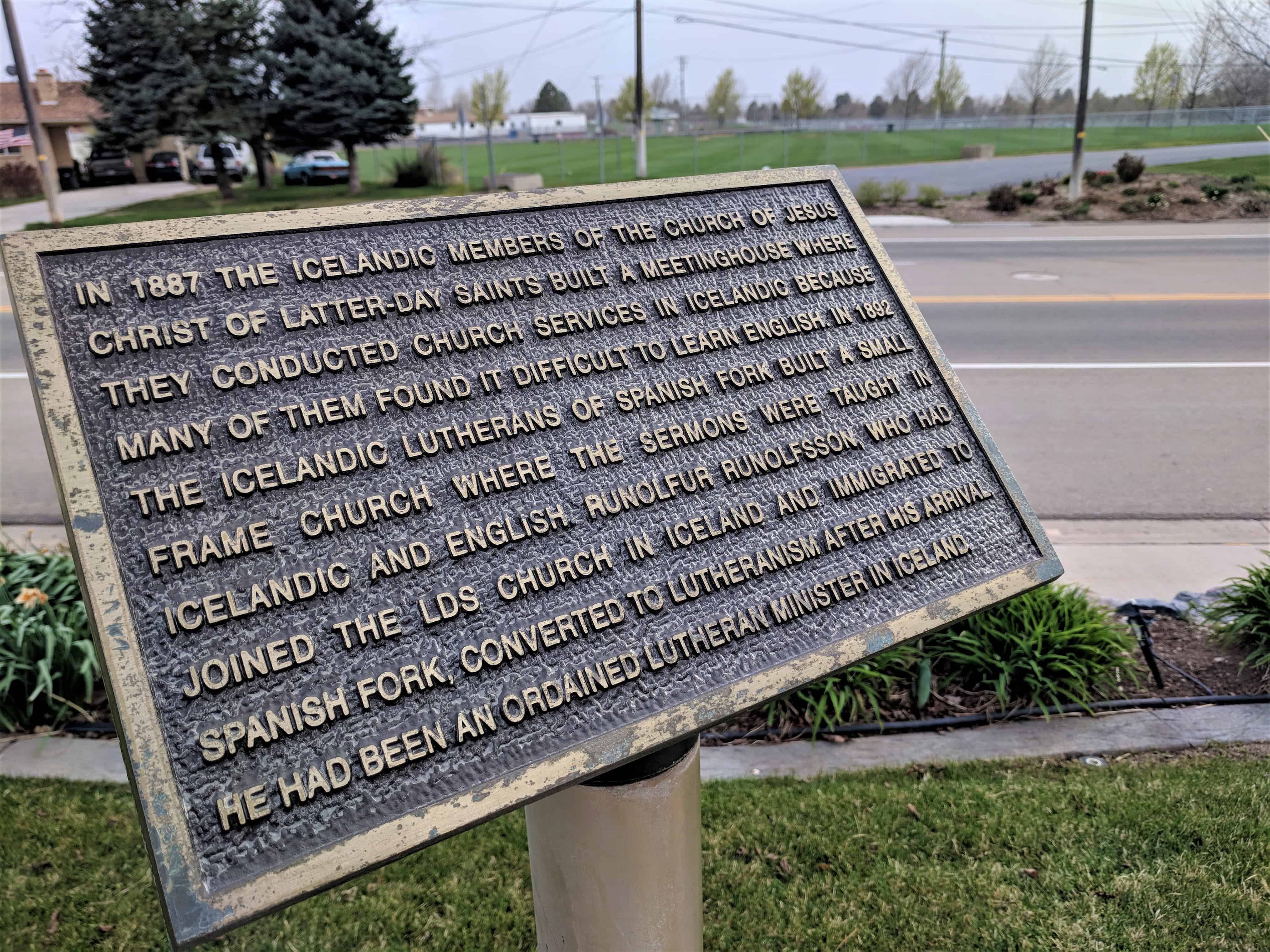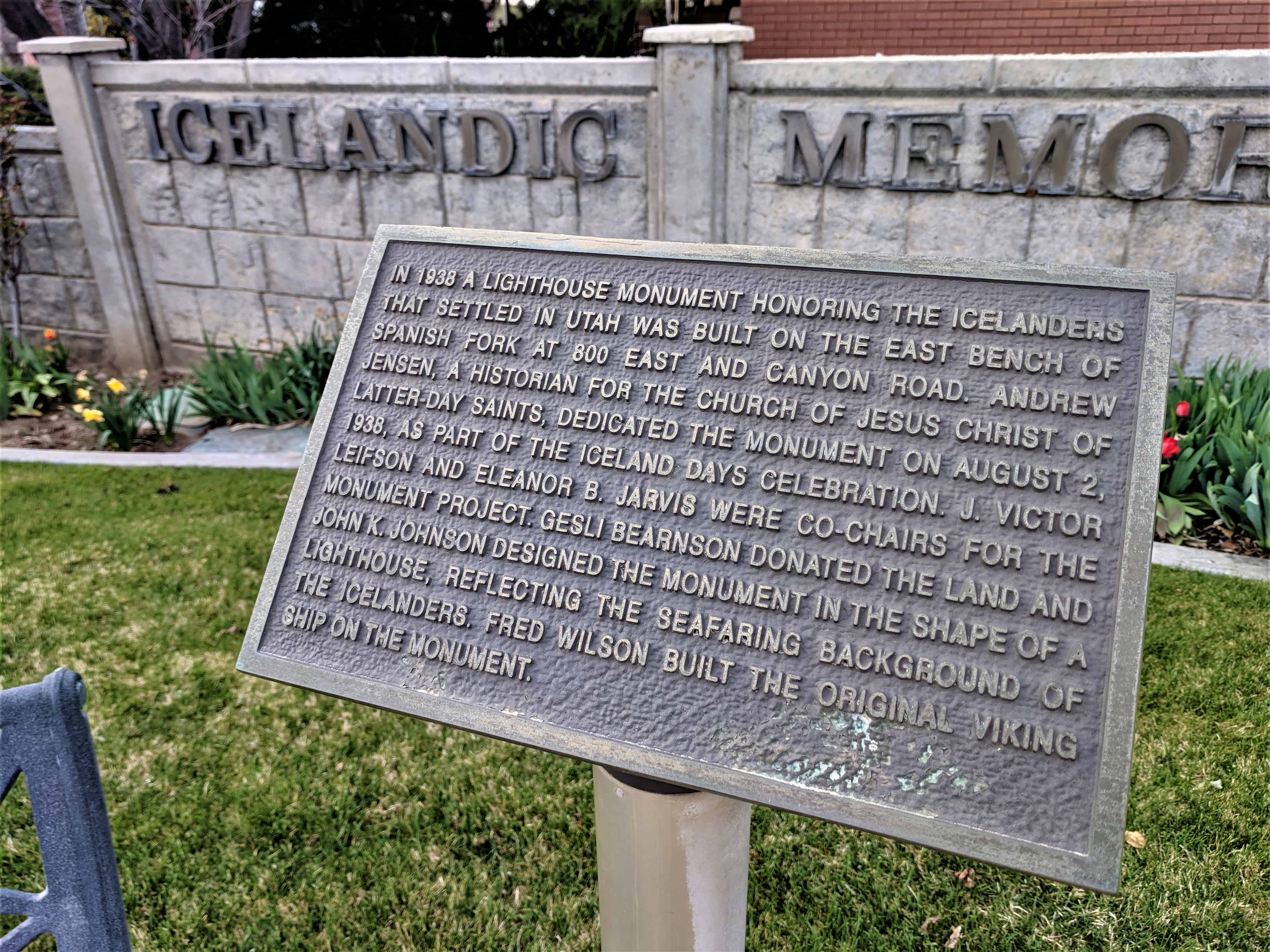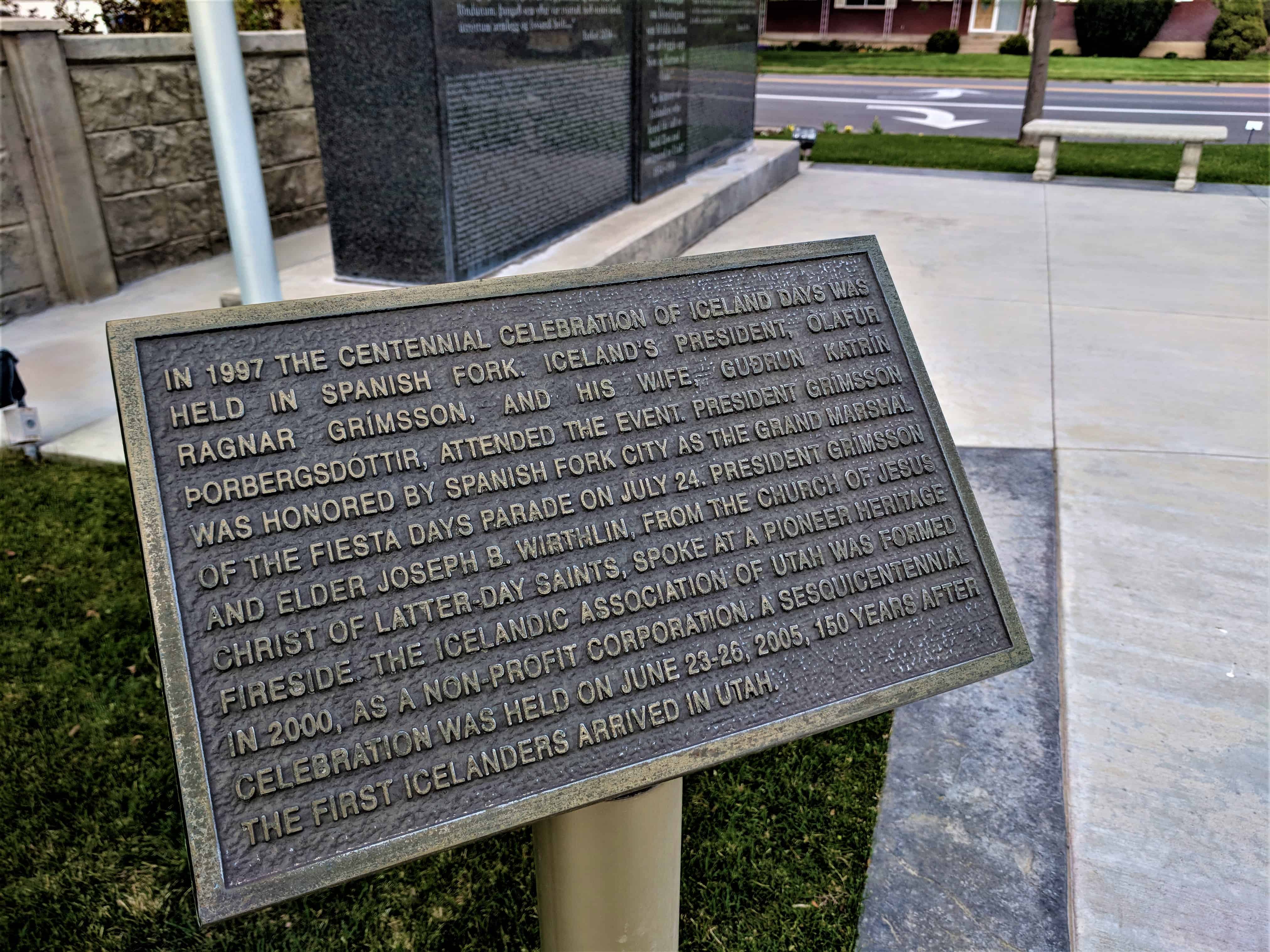Icelandic Memorial
See also: First Icelandic Settlement in USA
Rock From Iceland
Many Icelandic converts to The Church of Jesus Christ of Latter-day Saints were baptized on the shores of Vestmannaeyjar, Iceland, at what is called the “Mormon Pond.” This rock was removed from those shores on May 6, 2005 and brought to Spanish Fork. It stands as a symbol of the commitment, courage, and sacrifice of those who left to their posterity a legacy of faith, perseverance, and endurance.
Two natives of Iceland, Porarinn Halfidason and Gudmunder Gudmundsson, met two Mormon missionaries from Utah while studying in Copenhagen, Denmark, in 1851. After careful investigation, they converted to The Church of Jesus Christ of Latter-day Saints. They returned to their homeland to share their newfound faith. In 1852 Porarinn drown at sea. Gudmunder carried on the proselyting activities. Many converts were baptized on the shore of Vestmannaeyjar, Iceland.
In 1854 Samuel Bjarnson and his wife, Margret Gisladottir, and a traveling companion, Helga Johndottir, were the first converts to leave Iceland for Zion. They sailed from Iceland in November of 1854 to Liverpool, England, on the ship James Nesmith. From England, they continued on to New Orleans where they boarded a riverboat headed to St. Louis, Missouri. After passing through Mormon Grove, the group arrived in the Great Salt Lake Valley on September 7, 1855, 300 days after their departure from Iceland. Brigham Young, President of The Church of Jesus Christ of Latter-day Saints, directed Samuel, Margret, and Helga to settle in Spanish Fork, Utah. With a nucleus of 16 pioneers the first permanent Icelandic settlement in the United States was established in Spanish Fork.
Prior to 1869, Icelanders made the trip to Utah by sailing on ships, traveling in wagon trains, and pulling handcarts. After that time, they traveled to Utah by steamship and train. Over 400 Icelanders immigrated to Utah from 1855 to 1914. Because the pioneers had very little money to help themselves or others, they found it necessary to work together as they settled in their new homes. In 1887 the Icelanders in Spanish Fork held their first Iceland Days Celebration, Kate B. Carter wrote, “The Iceland people in Utah are said to have preserved the folk-lore and customs of their mother country more than any other nationality that pioneered in Utah.”
In 1887 the Icelandic members of The Church of Jesus Christ of Latter-day Saints built a meetinghouse where they conducted church services in Icelandic because many of them found it difficult to learn English. In 1892 the Icelandic Lutherans of Spanish Fork built a small frame church where the sermons were taught in Icelandic and English. Runolfur Runolfsson, who had joined the LDS Church in Iceland and immigrated to Spanish Fork, converted to Lutheranism after his arrival, he had been an ordained Lutheran minister in Iceland.
In 1938 a Lighthouse Monument honoring the Incelanders that settled in Utah was built on the east bench of Spanish Fork at 800 East and Canyon Road. Andrew Jensen, a historian for The Church of Jesus Christ of Latter-day Saints, dedicated the monument on August 2, 1938, as part of the Iceland Days celebration. J. Victor Leifson and Eleanor B. Jarvis were co-chairs for the monument project. Gesli Bearnson donated the land and John K. Johnson designed the monument in the shape of a lighthouse, reflecting the seafaring background of the Icelanders. Fred Wilson built the original Viking ship on the monument.
The centennial celebration of the first Icelanders coming to Utah was held on June 15-17, 1955. Elder Henry D. Moyle of The Church of Jesus Christ of Latter-day Saints opened the celebration as a keynote speaker during a religious service on Wednesday, June 15. The celebration included a parade and concluded on Friday, June 17, a national holiday in Iceland. The Iceland Association, in 2000, raised funds to build a monument in Vestmannaeyjar to honor their ancestors, along with an exhibit in Hofsos, Iceland.
Byron T. Geslison, his wife, Melva and their two sons, David and Daniel, were called to Iceland in 1975 to renew the missionary effort of The Church of Jesus Christ of Latter-day Saints. When the Geslisons arrived in Iceland there were no missionary discussions or tracts in Icelandic. Byron had the voice of warning and truth, written by Thordur Didriksson in 1879, re-printed to use as a missionary tract. The Icelandic government officially recognized The Church of Jesus Christ of Latter-day Saints on November 1, 1983.
In 1997 the centennial celebration of Iceland days was held in Spanish Fork. Iceland’s President, Olafur Ragnar Grimsson, and his wife, Gudrun Katrin Porbergsdottir, attended the event. President Grimsson was honored by Spanish Fork City as the Grand Marshal of the Fiesta Days Parade on July 24. President Grimsson and Elder Joseph B. Wirthlin, from The Church of Jesus Christ of Latter-day Saints, spoke at a pioneer heritage fireside. The Icelandic Association of Utah was formed in 2000, as a non-profit corporation. A sesquicentennial celebration was held on June 23-26, 2005, 150 years after the first Icelanders arrived in Utah.





















Pingback: First Icelandic Settlement in USA | JacobBarlow.com
Pingback: Spanish Fork, Utah | JacobBarlow.com
Very much enjoyed reading all this information and learning about the Icelanders’ immigration to Utah as my son in law is a Leifson.